
Panmunjom, also known as Panmunjeom, now located in Kaesong, North Hwanghae Province, North Korea, was a village just north of the de facto border between North and South Korea, where the 1953 Korean Armistice Agreement that paused the Korean War was signed. The building where the armistice was signed still stands.

Paju is a city in Gyeonggi Province, South Korea. Paju was made a city in 1997; it had previously been a county (gun).

Kijŏng-dong, Kijŏngdong, or Kijŏng tong, is a village in P'yŏnghwa-ri, Kaesong-si, North Korea. It is situated in the North's half of the Korean Demilitarized Zone (DMZ). Also known in North Korea as Peace Village, it has been widely referred to as 'Propaganda Village' by those outside North Korea, especially in South Korean and Western media.

Korea JoongAng Daily is the English language version of the South Korean national daily newspaper JoongAng Ilbo. The edition mainly carries news and feature stories by staff reporters, and some stories translated from the Korean language newspaper. It is one of three English-language daily newspapers in South Korea, along with The Korea Times and The Korea Herald.
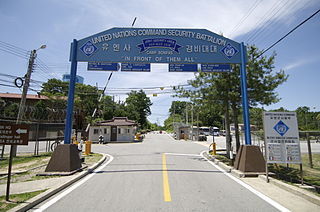
Camp Bonifas is a United Nations Command military post located 400 m (1,300 ft) south of the southern boundary of the Korean Demilitarized Zone. It is 2,400 m (7,900 ft) south of the Military Demarcation Line, which forms the border between South Korea and North Korea. It was returned to the Republic of Korea in 2006.

Imjingak, and sometimes in English called the Imjingak resort, is a park located on the banks of the Imjin River in the city of Paju, South Korea. The park has many statues and monuments regarding the Korean War. There is also a restaurant, an observation deck, a pool in the shape of the Korean peninsula, and even a small amusement park.
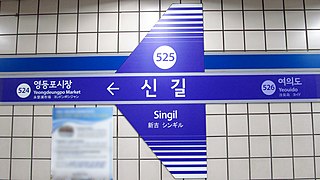
Singil Station is a station on the Seoul Subway's Line 1 and 5.
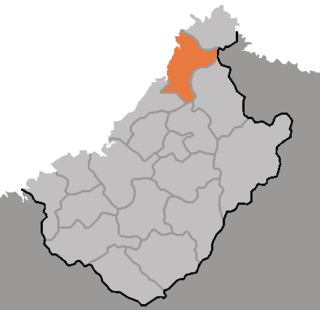
Chasŏng County is a county (kun) in Chagang Province, North Korea. The city is immediately south of the Chinese-North Korean border. Its approximate population to 7 km from the city center is 8,317. The average altitude is 1279 feet, or 389 meters. Nearby cities and towns include Haengjangp'yong and Umnae-dong.

Yodŏk County is a county in South Hamgyŏng province, North Korea. Originally part of Yŏnghŭng county, it became a separate entity as part of the 1952 reorganization of local government.

Ch'ŏrwŏn County is a kun, or county, in Kangwŏn province, North Korea. Portions of it were once a single county together with the county of the same name in South Korea; other portions were added from neighbouring counties in the 1952 reorganization of local governments. After the initial division of Korea, the entire county lay to the Northern side of the dividing line, but in the course of the Korean War part of the county was taken by the South.
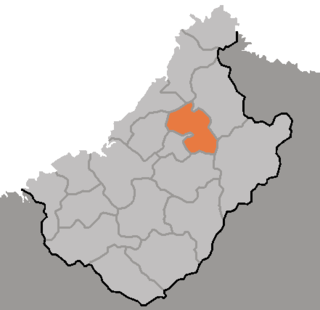
Changgang County is a kun, or county, in north-central Chagang province, North Korea. Originally part of Kanggye, it was made a separate county in 1949. It borders Hwapyong and Nangrim to the east, Kanggye and Sijung to the west, Songgan to the south, and Chasong to the north.

Kujang County is a kun, or county, in southeastern North P'yŏngan province, North Korea. It was created in 1952 from part of Nyŏngbyŏn county, as part of a nationwide reorganization of local government. It borders Nyŏngbyŏn on the west, Hyangsan and Unsan counties on the north, Nyŏngwŏn on the east, and Kaech'ŏn and Tŏkch'ŏn cities to the south.
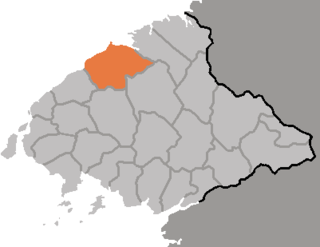
Sakju County is a kun, or county, in northern part of North P'yŏngan province, in North Korea. It lies along the Yalu River bordering the People's Republic of China to the north. Within North Korea, it borders Ch'angsŏng to the east, Ch'ŏnma and Taegwan to the south, and Ŭiju to the west.

Operation Courageous was a military operation performed by the United Nations Command (UN) during the Korean War designed to trap large numbers of Chinese People's Volunteer Army (PVA) and Korean People's Army (KPA) troops between the Han and Imjin Rivers north of Seoul, opposite the Republic of Korea Army (ROK) I Corps. The intent of Operation Courageous was for US I Corps, which was composed of the US 25th and 3rd Infantry Divisions and the ROK 1st Infantry Division, to advance quickly on the PVA/KPA forces and reach the Imjin River with all possible speed.
The Battle of Uijeongbu was a battle fought in Uijeongbu during the Korean War from 25 to 26 June 1950, during the North Korean invasion of South Korea.

Samgakji Station is a subway station on the Line 4 and Line 6 of the Seoul Metropolitan Subway. The Seoul War Memorial is a short walk away from exits 11 and 12. This station is on the west end of the Yongsan Garrison, which is a short walk from exit 13. Although not connected to this station by a transfer passageway, Namyeong Station on Line 1 is a short walk from here.
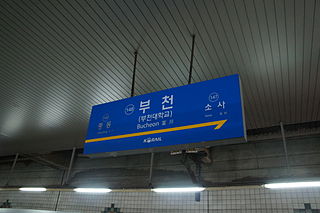
Bucheon Station is a ground level metro station located in Bucheon, South Korea. This station is on Seoul Subway Line 1. It was also once the southern terminus of the Gimpo Line, until its abandonment in 1980.
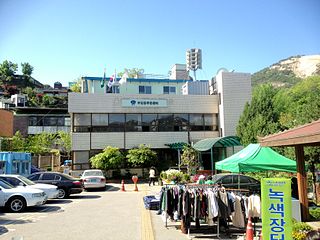
Buam-dong is a dong, neighbourhood of Jongno-gu in Seoul, South Korea.
Munsan-myeon is a myeon (township) in the northern part of Seocheon-gun, Chungcheongnam-do, South Korea. It is bordered by Masan-myeon to the east, Buyeo-gun's Oksan-myeon to the north, Pangyeon-myeon to the west, and Seocheon-eup's Sicho-myeon to the south. As of 2006 it had a population of 1,590.

Wolmido (월미도), also known as Wŏlmi-do, is an island 1 kilometer (0.62 mi) off the coast of South Korea near Incheon. It was connected to the mainland by a highway in 1989, and was later connected by a monorail which opened in late 2019. It is a weekend destination and tourist area, with restaurants, the theme park Play Hill and the areas Meeting Square, Arts Square, Performance Square, and Good Harvest Square.

















